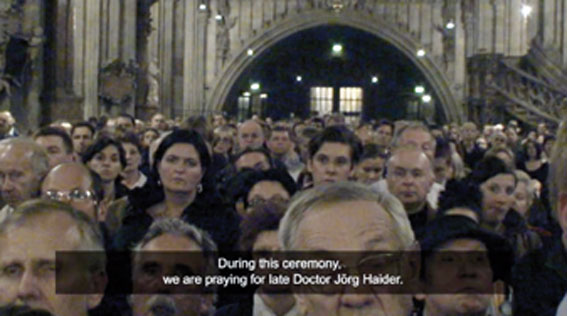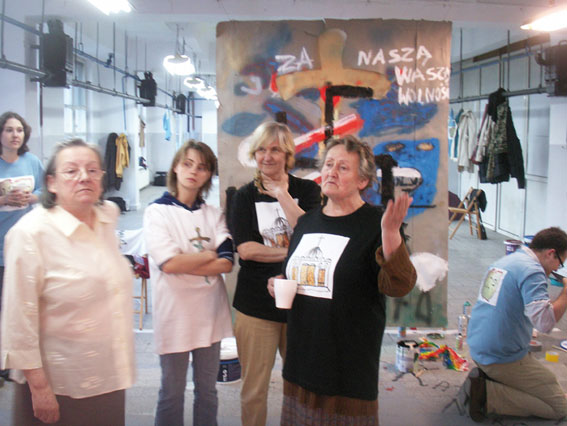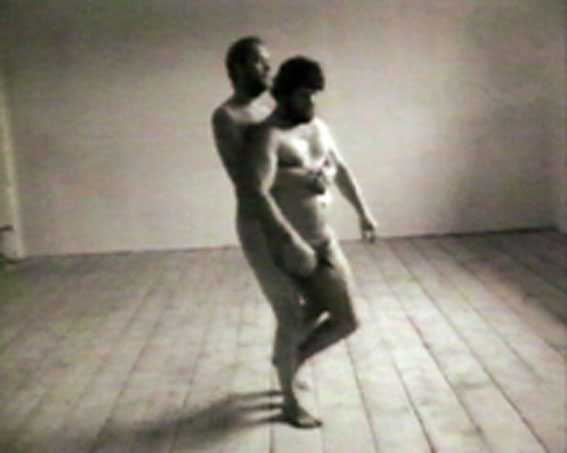Artur Zmijewski

Formé à la sculpture à l’Academy of Fine Arts de Varsovie au début des années 90, Artur Zmijewski abandonne ce médium après ses études au profit de la photographie et surtout de la vidéo, plus aptes selon lui à rendre compte de la complexité du monde. La vidéo lui permettrait de mettre en place des situations réelles, des déplacements et échanges opérés, dans une optique documentariste assez brute, même s’ils s’effectuent dans le cadre d’une image fabriquée. Pour son diplôme, il présente 40 Szuflad (40 tiroirs), un ensemble de 40 photographies représentant un homme et une femme pétrissant leurs corps, rangées dans un meuble de classement comprenant autant de tiroirs, dont les mécanismes, légèrement grippés, nécessitent d’être forcés pour être ouverts. Encore sculpturale, cette œuvre traduit déjà une obsession pour le corps que Zmijewski développera par la suite dans ses vidéos. Cette préoccupation semble commune à nombre d’artistes polonais des années 90, comme Katarzyna Kozyra ou Pawel Althamer, passés par l’atelier de Grzegorz Kowalski, qui les a familiarisés à la théorie de « la forme ouverte » théorisée par l’architecte Oskar Hansen en 1959, visant à encourager la communication et la collaboration avec d’autres participants, d’autres compétences ou instances sociales.

Artur Zmijewski, Democracies, 2009. Vidéo, 2 h 26 min. Single channel video, 2 hours 26 min. Courtesy de l'artiste, Galerie Peter Kilchmann, Zurich, Foksal Foundation, Warsaw.
Artur Zmijewski, c’est donc une affaire de corps, éclatés, détruits, différents, une altérité qui surgit de manière soudaine et violente dans le champ des représentations que lui refusent habituellement les standards de la normalité. Les handicaps s’exhibent nus et crûment dans Out for a Walk ou Oko za oko (Œil pour œil) ; des enfants sourds forment la chorale de The Singing Lesson, transformant une cantate de Bach en concert de rugissements et de cris ; les images d’un groupe d’enfants mentalement handicapés sont opposées à celles des animaux d’un zoo dans Ogrod Botaniczny/Zoo (Jardin botanique / Zoo). Les handicaps physique, mental, linguistique sont ici considérés comme des catégories de pouvoir, au même titre que la beauté, outil de contrôle des comportements véhiculé par la honte d’être « déficient », désagréable à la vue, à l’image d’un Freak de Browning. Pour Zmijewski, « le corps est notre construction – l’apparence que nous offrons sur le marché de l’échange social »1. Le corps peut ainsi être traumatique, historique, nationalisé s’il est mobilisé dans l’armée. Le spectateur, on l’aura compris, n’est pas épargné lorsqu’il est ainsi confronté, entre voyeurisme et obscénité, à la cruauté de l’expérience corporelle, à son propre dégoût ou à sa compassion, qui, écrit Zmijewski, « a été inventée à l’usage de ceux qui regardent – c’est leur alibi »2.

Artur Zmijewski THEM, 2007. Vidéo, 26:30 min. Single channel video, 26:30 min. Courtesy de l'artiste, Galerie Peter Kilchmann, Zurich, Foksal Foundation, Warsaw
Radicales et sans compromis, les œuvres d’Artur Zmijewski dérangent autant qu’elles fascinent dans leur manière d’outrepasser les conventions légales, morales et éthiques. Un artiste bon qu’à choquer le bourgeois ? Laissons chacun se faire une idée et penchons-nous sur une conception du rôle de l’art que l’on croyait abandonnée aux avant-gardes et à leur faillite annoncée. La critique a appris à se méfier (voire à railler) des œuvres politiques, d’un certain littéralisme, qui ne convainc, selon Rancière, que les convaincus. Mais pas de message chez Zmijewski, plutôt la mise en place d’une situation de rencontre entre des groupes d’individus qui ne se « côtoient » généralement pas (valides-invalides dans Eye for Eye, groupes sociaux antagonistes dans Them), la tentative de poser la question de l’influence de l’art sur la réalité. Il précise ses positions dans un article intitulé « Applied Social Arts », paru en 2007 dans la revue polonaise de gauche Krytyka Polityczna, dont il est le directeur artistique. Il y pose d’emblée deux questions fondamentales : « l’art contemporain peut-il avoir un impact social visible ? » et « pourquoi de telles questions sont-elles considérées comme des affronts à l’essence même de l’art »3. Sur le ton du manifeste, avec le lot d’excitation, d’ambiguïtés et de généralités propres au genre, il constate que, si « tous les mouvements d’avant-gardes considéraient l’art au même titre que les autres disciplines structurant la réalité », comme la science, la politique ou la religion, les conséquences réelles qu’il peut engendrer sont désormais suspectes. Il associe ce refus d’influencer, d’être un acteur social, à la peur d’être instrumentalisé, à une honte qui découlerait de l’engagement d’artistes auprès de régimes totalitaires comme le nazisme ou le socialisme soviétique. La honte est un élément structurant de la pensée de Zmijewski, qu’il envisage comme un outil de « contrôle des comportements »4. Ainsi aliéné, réduit à sa pure autonomie, l’art deviendrait inconséquent, sans impact vérifiable au regard de la science qui dicte ses vérités. Laissant indifférents les experts d’autres disciplines, il se replierait sur une esthétisation exacerbée. Certes « l’art peut être politique tant qu’il reste éloigné de la politique – il peut agir politiquement dans les galeries mais pas dans les débats de la vie réelle qui se déroulent dans un autre espace communautaire, tel que les médias ». Si les caractéristiques intuitives et imaginatives propres à l’art peuvent produire de l’expérience effective, Zmijewski préconise la mise en place de procédures cognitives proches de l’algorithme, comme métaphore d’une action possible, qui pourraient trouver une vérification sociale sans tomber dans un didactisme académique. L’art ne serait plus ainsi seulement une question formelle mais redeviendrait, si tant est qu’il l’ait déjà été, un agent utile et persuasif de la réalité, un « outil d’obtention et de dissémination des connaissances ». Pour cela, les artistes doivent apprendre à contrôler et à instrumentaliser l’autonomie et l’esthétique à des fins précises, mais aussi à empiéter sur d’autres champs, comme la science ou l’anthropologie, en collaborant avec des compétences étrangères aux phénomènes artistiques – ce qui exclut le critique comme seul garant des commentaires et des débats liés à l’art.

Artur Zmijewski An eye for an eye, 1998. Vidéo. Courtesy de l'artiste, Galerie Peter Kilchmann, Zurich, Foksal Foundation, Warsaw.
Si elles ne sont pas franchement nouvelles et finalement assez proches des thèses en vogue de Rancière sur le partage du sensible, les conceptions de Zmijewki semblent en total décalage avec les discours actuels sur l’art contemporain et ne sont pas sans susciter autant de perplexité que de jubilation. Reste à vérifier si ces théories sur l’utilité de l’art, sur son application, sont réellement effectives, ce que Zmijewski ne devrait pas manquer d’expérimenter en 2012 dans le cadre de la septième Biennale de Berlin dont il a été nommé commissaire.
1 « Artur Zmijewski, Philosophie à l’acte » in Gerald Matt, Interviews 2, ed. Kunsthalle Wien, 2008. Traduit du polonais par Jagna Ciuchta et Béatrice Méline.
2 Ibid.
3 Artur Zmijewski, « Applied Social Arts », Krytyka Polityczna, Novembre-décembre 2007. Sauf mention, les autres citations sont également extraites de cet article.
4 Gerald Matt, art.cit.
Artur Zmijewski
by Raphael Brunel
Artur Zmijewski studied sculpture at the Warsaw Academy of Fine Arts in the early 1990s, but abandoned that medium after graduating and turned to photography and, more particularly, video, which, in his view, were more likely to describe and record the world’s complexity. Video would enable him to set up real situations, movements and exchanges carried out from the somewhat harsh viewpoint of a documentary maker, even if they come into being within the framework of a manufactured image. For his degree he presented 40 Szuflad [40 Drawers], a set of 40 photographs depicting a man and a woman kneading their bodies, stored away in a filing cabinet with as many drawers, whose slightly jammed mechanisms had to be forced to be opened. This still sculptural work already conveys an obsession with the body which Zmijewski would subsequently develop in his videos. In the 1990s, this preoccupation seemed to be shared by a number of Polish artists, such as Katarzyna Kozyra and Pawel Althamer, who spent time at the studio of Grzegorz Kowalski, who familiarized them with the « open form » theory, in turn put forward by the architect Oskar Hansen in 1959, aimed at encouraging communication and cooperation with other participants, and other skills and expertise.
With Artur Zmijewski we are thus dealing with bodies that are shattered, destroyed and different, an otherness which suddenly and violently looms up in the field of representations which standards of normality usually refuse. Handicaps are displayed naked and crudely in Out for a Walk and Oko za oka [Eye for an Eye]; deaf children form the choir in The Singing Lesson, turning a Bach cantata into a concert of roars and cries; the pictures of a group of mentally handicapped children are contrasted with those of animals in a zoo in Ogrod Botaniczny/Zoo [Botanical Garden/Zoo]. Physical, mental and linguistic handicaps are here regarded as categories of powers, by the same token as beauty, a behavioural control tool conveyed by the shame of being « deficient », unpleasant to behold, like a Browning Freak. For Zmijewski, « the body is our construction-the appearance that we offer on the social exchange market »1. The body can thus be traumatic, historical, and nationalized, if it is mobilized in the army. The spectator, as we have gathered, is not spared when he is thus confronted, somewhere between voyeurism and obscenity, with the cruelty of the bodily experiment, with his own disgust or compassion, which, writes Zmijewski, « has been invented for the use of those who are onlookers-it is their alibi ».2
Artur Zmijewski’s radical and uncompromising works disturb as much as they intrigue, in the way that they go beyond legal, moral and ethical conventions. An artist only good at shocking the bourgeois? Let us allow everyone to have their own idea, and for our part focus on a conception of the role of art which we thought abandoned to the avant-gardes and their announced bankruptcy. Criticism has learnt to be suspicious of (not to say laugh at) political works, and a certain literalism, which, according to Rancière, only convinces the already convinced. But there are no messages in Zmijewski’s work, rather the introduction of a situation of encounter between groups of individuals who do not usually « rub shoulders » (able-bodied people and invalids in Eye for an Eye, antagonistic social groups in Them), the attempt to raise the issue of art’s influence on reality. He specified his stances in an article titled « Applied Social Arts », published in 2007 in the leftwing Polish magazine KrytykaPolityczna, where he has the job of artistic director. In it he right away asks two essential questions: « Can contemporary art have a visible social impact? » and: « Why are such questions considered as affronts to the very essence of art? »3. In the tone of a manifesto, complete with the excitation, ambiguities and generalities peculiar to the genre, he notes that, if « all avant-garde movements regarded by the same token as the other disciplines giving structure to reality », such as science, politics and religion, the real consequences that it may give rise to are henceforth suspect. He associates this refusal to influence and be a social player with the fear of being exploited, and with a shame that would result from the involvement of artists with totalitarian regimes like Nazism and Soviet socialism. Shame is a structure-giving factor in Zmijewski’s thinking, which he sees like a « behavioural control » tool ».4 Thus alienated, and reduced to its pure autonomy, art would become inconsequential, without any verifiable impact with regard to the science which dictates its truths. In leaving experts in other disciplines indifferent, it would turn inward to an exaggerated aestheticization. Needless to say, « art can be political as long as it remains removed from politics-it can act politically in galleries but not in debates about real life which are held in another communal space, such as the media ». If the intuitive and imaginative characteristics peculiar to art can produce effective experience, Zmijewski advocates the establishment of cognitive procedures akin to the algorithm, as a metaphor of a possible action, which might find a social verification without toppling into an academic didacticism. So art would no longer be just a formal question, but it would once more become, if so tempted as it already has been, a useful and persuasive agent of reality, a « tool for obtaining and disseminating knowledge ». To this end, artists have to learn to control and make full use of autonomy and aesthetics for precise purposes, but they must also learn how to encroach upon other fields, like science and anthropology, by working together with areas of expertise alien to artistic phenomena-which rules out critics as the sole guarantors of art-linked commentaries and discussions.
Zmijewski’s conceptions are not really new, and if, in the end of the day, they are somewhat akin to Rancière’s currently fashionable theses about the ‘distribution of the sensible’, they do seem completely out of kilter with present-day discourse about contemporary art, and they also give rise to as much perplexity as they do jubilation. It remains to be seen if these theories about the utility of art and its application are really effective, something which Zmijewski should certainly put to the test in 2012 at the 7th Berlin Biennial, which he has been appointed to curate.
1 « Artur Zmijewski, Philosophie à l’acte » in Gerald Matt, Interviews 2, Kunsthalle Wien, 2008. Translated rom the Polish by Jagna Ciuchta and Béatrice Méline.
2 Ibid.
3 Artur Zmijewski, « Applied Social Arts », Krytyka Polityczna, Novembre-décembre 2007. Except where otherwise mentioned, the other quotations are also taken from this article.
4 Gerald Matt, art.cit.
- Partage : ,
- Du même auteur : Nora Turato, Julien Creuzet, Ismaïl Bahri, Flora Moscovici, Eva Barto,
articles liés
Iván Argote
par Patrice Joly
Laurent Proux
par Guillaume Lasserre
Diego Bianchi
par Vanessa Morisset

